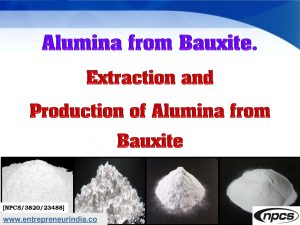
Alumina from Bauxite. Extraction and Production of Alumina from Bauxite
Alumina is the common name given to aluminum oxide (Al2O3). Alumina is produced from bauxite, an ore that is mined from topsoil in various tropical and subtropical regions. The Bayer process, discovered in 1887, is the primary process by which alumina is extracted from bauxite.
Bauxite is the general name given to the hydrated oxides of aluminium. It contains varying amounts of combined water and several impurities of which ferric oxide and silica are usually predominant. It is essential that the Al2O3 (alumina) be obtained substantially free from these impurities as otherwise the iron oxide and silica would be reduced and contaminate the metallic aluminium produced in the Hall (or Heroult) Process.
Uses & Applications:
The superior characteristics alumina can offer make it ideal for use in many applications. Some of the most common applications outside of aluminium production are listed below.
- Abrasives:
Alumina is widely used in a variety of industrial abrasive materials, owing to its superior hardness and strength. Similarly, alumina can be used as a coating to protect against abrasion.
- Refractories:
Alumina is also widely used in refractory products, due to its high melting point. It is especially suited to demanding applications where the strength of the refractory must be retained at high temperatures.
- Glass:
Alumina is often used in the production of glass products, lending improved strength; it has even been studied for its potential in creating an unbreakable glass.
- Engineered Ceramics:
Alumina is also widely used in engineered ceramics, also called advanced or technical ceramics. These engineered ceramic materials are formulated for especially harsh applications that require increased wear resistance, thermal and chemical stability, and many of the other characteristics alumina possesses. Engineered ceramics have applications in industries from chemical and medical, to industrial, electrical, and more.
- Other Applications:
laser tubes, Wear pads, Seal rings High temperature electrical insulators, High voltage insulators, Furnace liner tubes, Thread and wire guides, Electronic substrates, Ballistic armor, Abrasion resistant tube and elbow liners, Thermometry sensors, Laboratory instrument tubes and sample holders, Instrumentation parts for thermal property test machines, Grinding media.
Market Outlook
High Purity Alumina Market is expected to garner $5,293 million by 2023, registering a CAGR of 17.0% during the forecast period 2017-2023. The market for high purity alumina has witnessed tremendous growth during the past few years and is expected to grow at a CAGR of 20.7% in terms of volume, during the analysis period.
The bauxite and alumina market can be segmented as metallurgical and non-metallurgical products. A metallurgical segment includes the bauxite and alumina used for extraction of aluminum and is the largest product segment.
The major trend being witnessed in the global high-purity alumina market is the growing investments by market players in new plants for product manufacturing. Besides, investments are being focused upon the expansion of existing production units and the modernization and upgradation of aging facilities. This increase in investments for enhancing the production of alumina is expected to result in the greater availability of the product to meet the growing demand in the market.
Based on region, the market is categorized into Europe, North America, Asia-Pacific (APAC), Latin America, and the Middle East and Africa. Among all these regions, APAC held a significant share in the high-purity alumina market during the historical period. This can be majorly attributed to the growth in the construction industry of the region, particularly in infrastructure projects such as highways and roadways in China and India. The project developers across these nations are increasingly focusing on the adoption of LED lighting solutions for installation purposes in these structures, which, in turn, is boosting the growth of the high-purity alumina industry.
U.S. High Purity Alumina Market Size, By Application, 2014 – 2025 (USD Million)
High purity alumina market is witnessing steady growth in the semiconductor industry, as the product is a fairly new industrial-use material employed in the process of fabrication of semiconductor device. It is also used in wafer processing equipment owing to its high resistance to plasma corrosion and improved blending strength. Demand for semiconductor is influenced by several underlying applications such as data processing, communication and consumer electronics that accounts for the prominent share of applicability in personal computers, tablets, gaming consoles, television, iPods and servers. Hence, growing demand for high definition display screens is expected to augment the high purity alumina market demand in the forecast timespan.
The global market for high purity alumina is also driven by sapphire’s use in semiconductor applications. High purity alumina is used as separators in Li-ion batteries that are used in electronic devices and electric vehicles. The other applications of high purity alumina are abrasives, alumina ceramic, translucent cosmetics, and separation membrane.
High Purity Alumina (HPA) Market Volume Share (%), By Region (2018)
Altech Chemicals Limited, Baikowski SAS, Polar Sapphire Limited, Nippon Light Metal Company Limited, Alcoa Corporation, Orbite Technologies, Sasol, Sumitomo Chemical, Rio Tinto Alcan, UC RUSAL, Norsk hydro are some of the prominent players operating in the global high purity alumina market. Alcoa Corporation is among the top producers of aluminium. In 2016, Alcoa Inc. got split into two entities namely Alcoa Corporation and Arconic with former engaged in mining and manufacturing of raw alumina and the latter engaged in processing of alumina and other metals.
Alumina Industry in India:
Alumina is produced from bauxite. About one tonne of alumina is produced from three tonnes of bauxite and about one tonne of aluminium from two tonnes of alumina. The production of alumina at 36.10 lakh tonnes in 2012-13 decreased by about 8% as compared to the previous year.
Production of Alumina 2010-11 to 2012-13
Exports of Alumina (By Countries)
See more